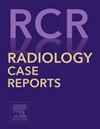The role of MRI in the management of patients with a histological diagnosis of B3 breast lesion after vacuum-assisted biopsy: A case report and a brief review of the literature
Q4 Medicine
引用次数: 0
Abstract
This case report and literature review examine the role of dynamic contrast enhanced magnetic resonance imaging (DCE-MRI) in managing of breast lesions diagnosed as B3 after vacuum-assisted biopsy (VAB). A 48-year-old female patient with first-degree family history of breast cancer, whose mammography, ultrasound, and magnetic resonance imaging (MRI) showed an area of parenchymal distortion in the left upper outer quadrant (UOQ), underwent a VAB, which revealed a B3 lesion (radial scar with atypia). She subsequently underwent a vacuum-assisted excision (VAE), and a 4-month follow-up MRI showed residual enhancement in the treated area; after a multidisciplinary discussion, she underwent surgery, which confirmed the complex sclerosing lesion (CLS) with atypia. The authors highlight the importance of MRI's high negative predictive value in excluding malignancy, especially in conjunction with VAE, which allows for more comprehensive tissue sampling and reduces the need for surgical excision in B3 cases. The multidisciplinary approach and correlation of radiological and pathological findings are emphasized as crucial for optimal patient management.
MRI在真空辅助活检后B3乳腺病变组织学诊断中的作用:1例报告和文献综述
本病例报告和文献综述探讨了动态对比增强磁共振成像(DCE-MRI)在处理真空辅助活检(VAB)后诊断为B3的乳腺病变中的作用。一位48岁女性患者,有乳腺癌一级家族史,其乳房x光、超声和磁共振成像(MRI)显示左侧上外象限(UOQ)实质扭曲区,行VAB检查,显示B3病变(异型型放射状瘢痕)。随后,她接受了真空辅助切除(VAE), 4个月的随访MRI显示治疗区域残留强化;经过多学科的讨论,她接受了手术,证实了复杂硬化病变(CLS)的异型性。作者强调了MRI在排除恶性肿瘤方面的高阴性预测值的重要性,特别是结合VAE,它允许更全面的组织采样,并减少B3病例手术切除的需要。多学科的方法和相关的放射和病理发现强调为最佳的病人管理至关重要。
本文章由计算机程序翻译,如有差异,请以英文原文为准。
求助全文
约1分钟内获得全文
求助全文
来源期刊

Radiology Case Reports
Medicine-Radiology, Nuclear Medicine and Imaging
CiteScore
1.10
自引率
0.00%
发文量
1074
审稿时长
30 days
期刊介绍:
The content of this journal is exclusively case reports that feature diagnostic imaging. Categories in which case reports can be placed include the musculoskeletal system, spine, central nervous system, head and neck, cardiovascular, chest, gastrointestinal, genitourinary, multisystem, pediatric, emergency, women''s imaging, oncologic, normal variants, medical devices, foreign bodies, interventional radiology, nuclear medicine, molecular imaging, ultrasonography, imaging artifacts, forensic, anthropological, and medical-legal. Articles must be well-documented and include a review of the appropriate literature.
 求助内容:
求助内容: 应助结果提醒方式:
应助结果提醒方式:


